

Vagus Nerve Drives Motivation and Reward in Surprising Ways These are exciting times when it comes to state-of-the-art research that advances our understanding of the vagus nerve and how it works.
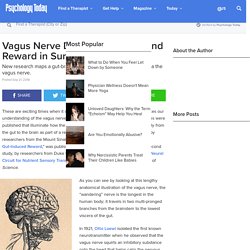
This week, two new studies were published that illuminate how the vagus nerve communicates messages directly from the gut to the brain as part of a reward and motivation system. The first study, by researchers from the Mount Sinai School of Medicine, “A Neural Circuit for Gut-Induced Reward,” was published September 20 in the journal Cell. The second study, by researchers from Duke University School of Medicine, “A Gut-Brain Neural Circuit for Nutrient Sensory Transduction,” appears in the September 21 issue of Science.
Early anatomical drawing of the vagus nerve. Vagus means "wandering" in Latin. Source: Wellcome Library/Public Domain article continues after advertisement Dopamine has long been known as a neural transmitter that drives reward and motivation. The Gut-Brain Axis May Be Hardwired (and Not Hormonal) Source: metamorworks/Shutterstock. Vagus Nerve Facilitates Guts, Wits, and Grace Under Pressure. Anxiety disorders have become a nationwide epidemic.
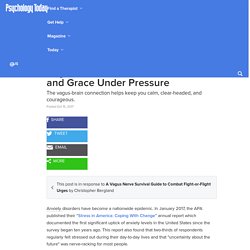
In January 2017, the APA published their “Stress in America: Coping With Change (link is external)” annual report which documented the first significant uptick of anxiety levels in the United States since the survey began ten years ago. This report also found that two-thirds of respondents regularly felt stressed out during their day-to-day lives and that "uncertainty about the future" was nerve-racking for most people. Along this same line, on October 15, 2017, The New York Times Magazine published an article, “Why Are More Teenagers Than Ever Suffering From Severe Anxiety? (link is external)” The subtitle of this article puts the conundrum of how best to cope with young Americans' anxiety disorders in the spotlight: “Parents, therapists, and schools are struggling to figure out whether helping anxious teenagers means protecting them or pushing them to face their fears.”
But there is some good news. Vagus Nerve Stimulation Helps Treatment-Resistant Depression. Vagus Nerve Stimulation Dramatically Reduces Inflammation. Vagus nerve in yellow.
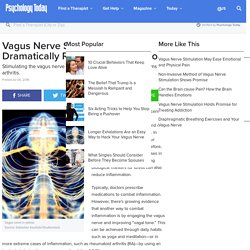
Source: Sebastian Kaulitzki/Shutterstock Inflammatory responses play a central role in the development and persistence of many diseases and can lead to debilitating chronic pain. In many cases, inflammation is your body's response to stress. Therefore, reducing "fight-or-flight" responses in the nervous system and lowering biological markers for stress can also reduce inflammation. article continues after advertisement Typically, doctors prescribe medications to combat inflammation.
The vagus nerve is known as the "wandering nerve" because it has multiple branches that diverge from two thick stems rooted in the cerebellum and brainstem that wander to the lowest viscera of your abdomen touching your heart and most major organs along the way. In 1921, a German physiologist named Otto Loewi discovered that stimulating the vagus nerve caused a reduction in heart rate by triggering the release of a substance he coined Vagusstoff (German for "Vagus Substance”).
Peripheral nervous system. Autonomic nervous system. The autonomic nervous system (ANS or visceral nervous system or involuntary nervous system) is the part of the peripheral nervous system that acts as a control system that functions largely below the level of consciousness to control visceral functions,[1] including heart rate, digestion, respiratory rate, salivation, perspiration, pupillary dilation, micturition (urination), sexual arousal, breathing and swallowing.
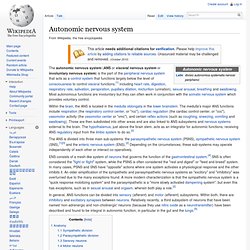
Most autonomous functions are involuntary but they can often work in conjunction with the somatic nervous system which provides voluntary control. Within the brain, the ANS is located in the medulla oblongata in the lower brainstem. The medulla's major ANS functions include respiration (the respiratory control center, or "rcc"), cardiac regulation (the cardiac control center, or "ccc"), vasomotor activity (the vasomotor center or "vmc"), and certain reflex actions (such as coughing, sneezing, vomiting and swallowing).
Anatomy[edit] Sympathetic division[edit] Sympathetic nervous system. Parasympathetic nervous system. The parasympathetic nervous system (PSNS) is one of the two divisions of the autonomic nervous system (a division of the peripheral nervous system (PNS)), the other being the sympathetic nervous system.[1][2] (The enteric nervous system (ENS) is now usually referred to as separate from the autonomic nervous system since it has its own independent reflex activity.)
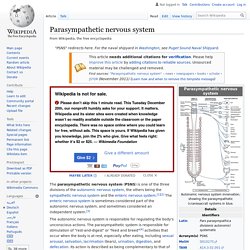
The autonomic nervous system is responsible for regulating the body's unconscious actions. The parasympathetic system is responsible for stimulation of "rest-and-digest" or "feed and breed"[3] activities that occur when the body is at rest, especially after eating, including sexual arousal, salivation, lacrimation (tears), urination, digestion and defecation. Its action is described as being complementary to that of the sympathetic nervous system, which is responsible for stimulating activities associated with the fight-or-flight response. Structure[edit] Cranial nerves[edit] Vagus nerve. The vagus nerve (/ˈveɪɡəs/ VAY-gəs), historically cited as the pneumogastric nerve, is the tenth cranial nerve or CN X, and interfaces with the parasympathetic control of the heart, lungs, and digestive tract.
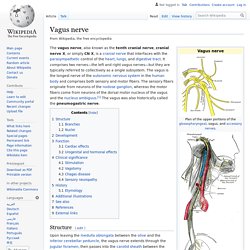
HRV.
Inflammation. Microbiota. The Athlete's Way.